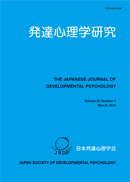Volume 17, Issue 2
Displaying 1-8 of 8 articles from this issue
- |<
- <
- 1
- >
- >|
-
Article type: Article
2006Volume 17Issue 2 Pages 103-114
Published: August 20, 2006
Released on J-STAGE: July 27, 2017
Download PDF (1469K) -
Article type: Article
2006Volume 17Issue 2 Pages 115-125
Published: August 20, 2006
Released on J-STAGE: July 27, 2017
Download PDF (1289K) -
Article type: Article
2006Volume 17Issue 2 Pages 126-137
Published: August 20, 2006
Released on J-STAGE: July 27, 2017
Download PDF (1524K) -
Article type: Article
2006Volume 17Issue 2 Pages 138-147
Published: August 20, 2006
Released on J-STAGE: July 27, 2017
Download PDF (1238K) -
Article type: Article
2006Volume 17Issue 2 Pages 148-158
Published: August 20, 2006
Released on J-STAGE: July 27, 2017
Download PDF (1362K) -
Article type: Article
2006Volume 17Issue 2 Pages 159-170
Published: August 20, 2006
Released on J-STAGE: July 27, 2017
Download PDF (1457K) -
Article type: Article
2006Volume 17Issue 2 Pages 171-181
Published: August 20, 2006
Released on J-STAGE: July 27, 2017
Download PDF (1392K) -
Article type: Article
2006Volume 17Issue 2 Pages 182-192
Published: August 20, 2006
Released on J-STAGE: July 27, 2017
Download PDF (1419K)
- |<
- <
- 1
- >
- >|
